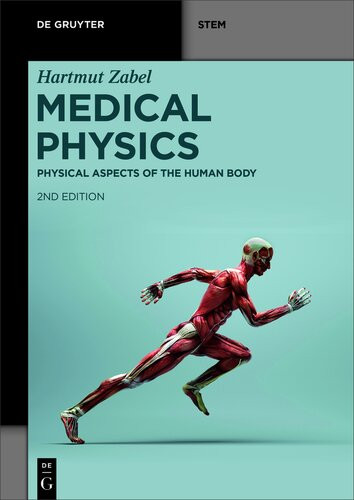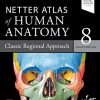Physical Aspects of the Human Body 2nd Edition by Hartmut Zabel ISBN 9783110756982 3110756986
$50.00 Original price was: $50.00.$25.00Current price is: $25.00.
Physical Aspects of the Human Body 2nd Edition by Hartmut Zabel – Ebook PDF Instant Download/Delivery: 9783110756982 ,3110756986
Full download Physical Aspects of the Human Body 2nd Edition after payment

Product details:
ISBN 10: 3110756986
ISBN 13: 9783110756982
Author: Hartmut Zabel
Physical Aspects of the Human Body 2nd Edition Table of contents:
1 Brief overview of body parts and functions
1.1 Introduction
1.2 Overview
1.2.1 Cell
1.2.2 Circulation
1.2.3 Heart
1.2.4 Kidneys
1.2.5 Respiratory system
1.2.6 Digestive system
1.2.7 Sensory organs
1.2.8 Nervous system
1.2.9 Locomotor system
1.2.10 Skin
1.2.11 Reproductive system
1.3 Summary
Suggestion for home experiments
2 Body mechanics and muscles
2.1 Basic mechanical terms
2.1.1 Body density
2.1.2 Symmetry planes
2.1.3 Center of gravity
2.2 Body mechanics
2.2.1 Mechanical models
2.2.2 Levers
2.2.3 Mechanical stability
2.2.4 Femur
2.2.5 Degrees of freedom
2.2.6 Biomechanics of walking
2.3 Skeletal muscles
2.3.1 Structure of skeletal muscles
2.3.2 Hierarchical organization
2.3.3 Muscle contraction
2.3.4 Muscle tension
2.3.5 Muscle activation
2.3.6 Coordination and feedback
2.4 Summary
Suggestions for home experiments
3 Elastomechanics: beams, bones, and fractures
3.1 Introduction
3.2 Elastic deformation
3.2.1 Strain and stress
3.2.2 Hooke’s law
3.2.3 Shear deformation
3.3 Elastic properties of beams
3.4 Plastic deformation and fracture
3.5 Viscoelastic materials
3.6 Structure of bones
3.6.1 Hierarchical structure of bones
3.6.2 Cellular structure of bones
3.7 Elastic and plastic properties of bones
3.7.1 Macroscopic level
3.7.2 Microscopic level
3.8 Summary
Suggestions for home experiments
4 Energy household of the body
4.1 The body as a thermodynamic machine
4.2 Metabolism
4.3 Caloric oxygen equivalent
4.4 Respiratory exchange ratio
4.5 Basal metabolic rate
4.6 Oxygen uptake
4.7 Efficiency of physical work
4.8 Metabolic heat production
4.9 Heat losses of the body
4.9.1 Heat conduction
4.9.2 Heat radiation
4.9.3 Convection
4.9.4 Sweating and shivering
4.9.5 Equilibrium condition
4.10 Summary
Suggestions for home experiments
5 Resting potential and action potential
5.1 Introduction
5.2 Cell membrane and ion channels
5.3 Resting potential
5.4 Action potential
5.5 Electrochemical properties of cells
5.5.1 Membrane capacitance
5.5.2 Transmembrane ion exchange
5.5.3 Transmembrane resistance
5.5.4 Depolarization time constant
5.5.5 Electrochemical potential
5.5.6 Hodgkin–Huxley model
5.6 Single channel conductance
5.7 ATP-powered Na+–K+ pump
5.8 Summary
Suggestions for home experiments
6 Signal transmission in neurons
6.1 Introduction
6.2 Overview on signal transmission
6.2.1 Components of neurons
6.2.2 Afferent and efferent neurons
6.2.3 Unipolar and multipolar neurons
6.3 Sensory receptor potential
6.4 Signal transduction
6.5 Saltatory polarization current
6.6 Electrochemical properties of axons
6.6.1 Transmembrane capacitance
6.6.2 Resistance and time constant
6.6.3 Decay length of action potential
6.6.4 Propagation velocity of action potentials
6.6.5 Experimental test of propagation velocity
6.7 Communication across axons
6.8 Neuromuscular junction – triggering muscle contraction
6.9 Electric and magnetic signals from the body
6.9.1 Electromyography (EMG)
6.9.2 Electroencephalography (EEG)
6.9.3 Magnetoencephalography (MEG)
6.10 Summary
Suggestions for home experiments
7 Electrophysical aspects of the heart
7.1 Introduction
7.2 Cardiac action potential
7.2.1 Temporal evolution
7.2.2 Spatial evolution
7.3 Electric polarization of the heart
7.3.1 Transmembrane potential
7.3.2 Dipole looping
7.3.3 Isopotential lines
7.4 Einthoven triangle
7.4.1 Coordinate system
7.4.2 Heart vector
7.5 Electrocardiogram
7.5.1 Einthoven leads
7.5.2 Goldberger leads
7.5.3 Wilson leads
7.6 Electrocardiography
7.6.1 Procedures
7.6.2 New developments
7.7 Magnetocardiography
7.8 Artificial pacemaker
7.9 Summary
Suggestions of home experiments
8 The physical aspects of the circulatory system
8.1 Introduction
8.2 Two circuits
8.3 The heart as a pump
8.3.1 Four phases
8.3.2 Stroke volume
8.3.3 Energy, power, and efficiency
8.4 Hemostatics of the systemic circuit
8.4.1 Hemostatic pressures
8.4.2 Elastic properties of blood vessels
8.5 Hemodynamics of the systemic circuit
8.5.1 Basic equations and assumptions
8.5.2 Pulsatile flow
8.5.3 Perfusion and flow resistance
8.5.4 Total peripheral flow resistance
8.5.5 Turbulent flow and Windkessel function
8.5.6 Mathematically modeling
8.5.7 Flow velocity and pulse wave velocity
8.5.8 Methods for determining PWV
8.6 Physical properties of blood
8.6.1 Composition of blood
8.6.2 Viscosity of blood
8.6.3 Osmotic pressure
8.7 Blood as an oxygen carrier
8.7.1 Structure of hemoglobin
8.7.2 Saturation curve
8.7.3 Ferritin
8.7.4 Light absorbance
8.8 Cardiopulmonary bypass intervention
8.8.1 Cardiopulmonary bypass
8.8.2 Oxygenator
8.9 Summary
Suggestions for home experiments
9 Physical aspects of the respiratory system
9.1 Introduction
9.2 Organs of the respiratory system (overview)
9.3 Gas exchange
9.3.1 Partial pressures of the atmosphere
9.3.2 Alveolar pressures
9.3.3 Solubility of gases in water
9.3.4 Solubility of oxygen in blood
9.3.5 Carbon dioxide transport in blood
9.3.6 Gas exchange in the alveoli
9.3.7 Respiratory coefficient and exchange rate
9.4 Tidal volume and vital capacity
9.4.1 Inspiratory and expiratory air volumes
9.4.2 Inspirational oxygen flow and cardiac output
9.5 Pulmonary volume and pressure changes
9.6 Volume work, compliance, and surface tension
9.6.1 Volume work
9.6.2 Compliance
9.6.3 Surface tension
9.7 Airway resistance
9.7.1 Total airway resistance
9.7.2 Turbulent flow
9.7.3 Time constant
9.8 Lung ventilators and oxygen generators
9.8.1 Invasive and noninvasive ventilators
9.8.2 Oxgen generators
9.9 Summary
Suggestions for home experiments
10 Physical aspects of the urinary system
10.1 Introduction
10.2 Global properties of kidneys
10.3 Structure of kidneys
10.4 Filtration
10.5 Reabsorption
10.6 Renal clearance
10.6.1 Renal clearance fundamentals
10.6.2 Case studies of renal clearance
10.6.3 Creatinine clearance
10.6.4 Urinary excretion
10.7 Artificial filtering: Hemodialysis
10.8 Bladder, urethra, and urination
10.8.1 Structure and function
10.8.2 Neural control
10.8.3 Urostatics and urodynamics
10.9 Summary
Suggestion for home experiments
11 Physical aspects of vision
11.1 Introduction
11.2 Anatomical aspects of the eye
11.3 The dioptric eye
11.3.1 The refractive power of the eye
11.3.2 Accommodation
11.3.3 Resolving power
11.3.4 Visual acuity
11.3.5 Lens aberrations
11.3.6 Intraocular pressure
11.3.7 The visual field
11.4 Photoreception
11.4.1 Structure of the retina
11.4.2 Sensitivity and adaptation
11.5 Phototransduction
11.5.1 Visual pigment rhodopsin
11.5.2 Photoisomerization
11.5.3 Three cycles to control receptor potential
11.5.4 Phototransduction: from photoreceptors to ganglion cells
11.6 Retinal signal processing
11.6.1 On–off bipolar cells
11.6.2 Receptive field
11.6.3 Lateral inhibition
11.7 Optic pathway
11.7.1 The optic nerve
11.7.2 Lateral geniculate nucleus and primary visual cortex
11.7.3 Binocular vision
11.8 Color perception
11.8.1 Tricolor and four-color systems
11.9 Summary
Suggestions for home experiments
12 Sound, sound perception, and balance
12.1 Introduction
12.2 Sound waves
12.2.1 Acoustic impedance
12.2.2 Crossing borders
12.2.3 Sound intensity and loudness
12.3 Outer and middle ear
12.3.1 Outer ear
12.4 Sound detection in the inner ear
12.4.1 Structure of the cochlea
12.4.2 Elastic properties of the cochlea
12.4.3 Organ of Corti
12.4.4 Inner and outer hair cells
12.4.5 Mechanoelectric transduction
12.4.6 Frequency coding
12.4.7 Selectivity, sensitivity, latency, and adaptation
12.4.8 Pathway to the auditory cortex
12.4.9 Sound localization
12.5 From sound generation to hearing loss
12.5.1 Tone, sound, and noise
12.5.2 Hearing loss
12.5.3 Hearing devices
12.5.4 The making of sound
12.6 Organ of equilibrium
12.7 Summary
Suggestions for home experiments
13 Prosthetics
13.1 Introduction
13.2 Exoprostheses
13.2.1 Lower limb prostheses
13.2.2 Upper limb prostheses
13.3 Hip replacement
13.3.1 Anatomical basics
13.3.2 Replacement procedures
13.3.3 Material considerations
13.3.4 Alternative approaches
13.4 Knee replacement
13.5 Cardiovascular stents
13.6 Retinal implants
13.6.1 Epiretinal microelectrode array
13.6.2 Subretinal micro-photodiode array
13.7 Summary
People also search for Physical Aspects of the Human Body 2nd Edition:
physical aspect of health
aspects of human anatomy
physical aspect definition biology
aspects of health related to the body is called
aspects of physiology
Tags: Hartmut Zabel, Physical Aspects, Human Body
You may also like…
Arts
The Human Body In Color Volume 1 9th Edition by Speedy Publishing ISBN B00RVZLS6W 9781635013979
Medicine - Diseases
Diseases of the Human Body 7th Edition by Carol Tamparo, Jennifer Davis 1719640386 9781719640381
Biology and other natural sciences - Human Biology
Medicine - Anatomy and physiology
Vander’s Human Physiology: The Mechanisms of Body Function 16th Edition Eric Widmaier
Medicine - Anatomy and physiology
Human Body Identification Manual Your body and how it works Quarto Knows
Uncategorized
Medical Physics Physical Aspects of the Human Body De Gruyter STEM 2nd Edition Hartmut Zabel
Reference - Other Reference By Subject
Uncategorized
Uncategorized











